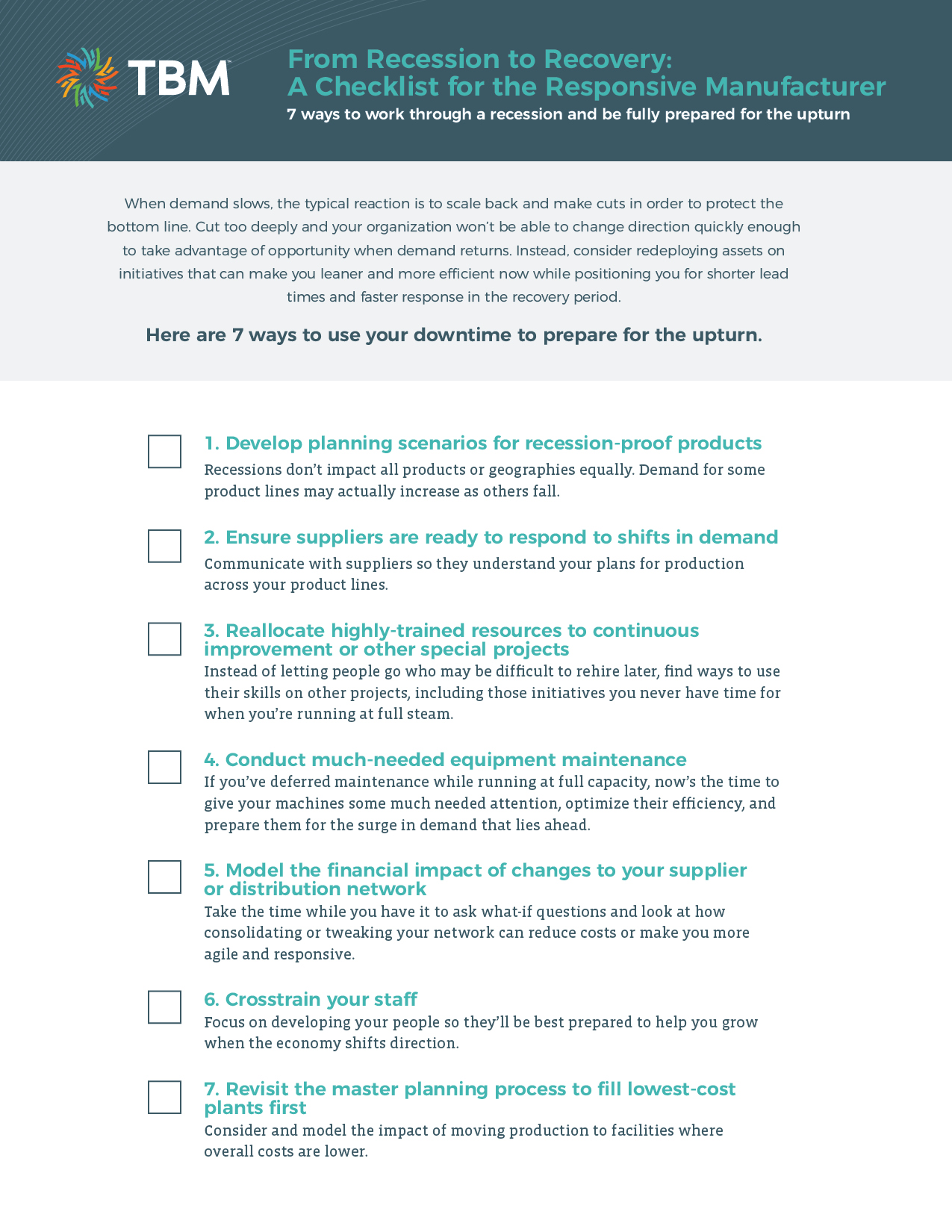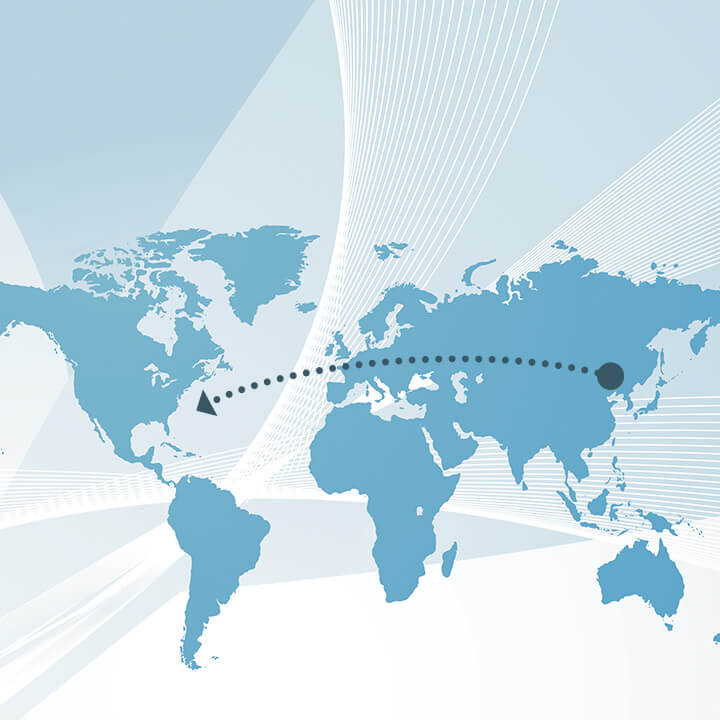Looking Beyond the Recession: How to Make the Most of the Recovery by Using Your Downtime to Prepare for the Upturn
Maybe you’re already feeling the effects of a soft economy. Or you are anticipating a slowdown in demand based on rumblings about a recession and an increasingly cautious mindset amongst key customers. The good news is the dip won’t last long. Economists tend to agree that any impending recession will be mild and short-lived, followed by a period of renewed growth later next year. In a recent post, we shared some thoughts on four critical actions firms should take during a recession. In this post, we want to offer some specific recommendations in order to be prepared for the recovery.
While you may need to scale back in some areas to weather the downturn, the key is to avoid making drastic business decisions that could hinder your ability to respond once the economy improves. We saw several companies make these types of mistakes during the last recession. And they paid the price when they couldn’t gear back up quickly enough to respond to demand during the recovery.
Here are some lessons learned the hard way along with advice for avoiding the same mistakes and ensuring your business can hit the ground running when the economy rebounds again:
Start planning for the upturn right now
If demand is falling or expected to fall, companies tend to focus on the immediate crisis at hand. Ideally, they will run analytics based on the expected rates of decline, looking at multiple scenarios, such as a 1%, 2%, or 5% drop in demand. And they will conduct what-if modeling to determine the financial impact of various decisions that can help slow down production, such as eliminating a shift, closing a line, or even consolidating locations.
In these situations, it’s important to keep in mind that it’s usually not as simple as a 1-5% decline across the board. In periods of economic sluggishness, not all regions and product lines are impacted equally. Demand for some products, particularly lower-priced or ‘economy’ products, could actually go up. This complicates scenario planning, but it’s important for executives to get the most complete picture of actual demand in order to inform choices around where to cut back on production, staff, or costs.
At the same time, operations leaders must be thinking about how they will reverse direction and scale back up quickly when demand returns. Again, planning for multiple rates of rebound growth and considering the product mix and regional impact will be key. Serious, on-going discussion on business conditions and new sales opportunities can help companies make more informed choices and best manage capacity. If, for example, demand is expected to recover in one region more quickly than others, is it a viable option to move production or warehousing closer to that region?
In addition, executives need to be thinking outside their own four walls to ensure their key suppliers are ready to respond to the shifts. In one instance, when demand for a specific frozen drink skyrocketed, the company found itself struggling to capitalize on that opportunity because its supplier couldn’t provide the right sized beverage containers quickly enough. Creating detailed playbooks for the expected rate of recovery and ensuring all the pieces are in place to execute those plans can help companies profitably reap the rewards of renewed growth when demand inevitability returns.
Avoid cutting resources you can’t get back
While no company can afford to run at max production when demand is low, making cuts that are too deep or cutting critical resources can leave a business hamstrung when the economy picks back up. Given that the economic downturn is expected to be short-lived, consider repurposing resources as opposed to eliminating them.
Seasonal businesses deal with this challenge all of the time. In the ATM business, which tends to ebb and flow with construction, the practice of hiring people in the busy season then laying them off when the weather turns cold can take a toll in terms of quality. The cost of retraining workers each season also cuts into profitability. Planning ahead and finding ways to move highly trained people into other roles or locations during the downtime helps these businesses mitigate the costs associated with the continuous cycle of hiring and firing.
Resist the urge to cut back on continuous improvement investments
When revenue takes a hit, it’s hard to justify spending on business improvements. But it is the prime time to focus on production efficiency and supply chain adjustments when you’re not spending every minute cranking out orders. Cutting fat now means you can operate more efficiently in the slow times. It also helps shorten lead times so you can ramp back up quickly in the recovery. In any economic circumstance, efficiency ensures you are always bringing your A game.
WIKA Instrument Corporation, a leading international manufacturer of pressure gauges and other critical measurement instruments, demonstrated the power of lean when the global economic recession caused a double-digit sales decline in 2009. “What was remarkable was the fact that we still made 2009 a good year in terms of profitability, and how we managed the sudden and unpredicted 30% upswing to set new records in 2010,” said the company’s president and former CEO, Michael Gerster. “It’s impossible to think of going through such a swing without our lean mindset.”
While you have the time, consider conducting equipment maintenance you may have put off during your busier season. It’s also a great time to look at overall maintenance practices and establish a maintenance excellence program that can ensure equipment can be utilized at full capacity when demand returns. Consider cross training staff, improving organization, or streamlining operations to further reduce lead times. Another worthwhile effort is to look closely at the cost structure of each facility and consider changes to the S&OP and master planning process to fill the lowest cost plants first. There will be differences in logistic costs based on moves you make, but often the conversion costs more than offset increases in freight or distribution.
Externally, you can review your supplier network and distribution network and uncover opportunities for cost savings and efficiency by asking those what-if questions and modeling the financial impact of potential changes. All of these initiatives provide opportunities to redeploy talent assets, helping you hang on to key people.
Put yourself in the best position to thrive
While recessions are rarely welcomed by business leaders, it’s important to remember that they are not all bad news. Below is a checklist for using your downtime wisely to drive further efficiency, ask what-if questions, and plan for taking full advantage of the recovery.

By approaching the recession as an opportunity to reassess your business and channel available resources toward strategic changes, you can help your organization come out of the slow period reenergized and fully prepared to embrace new levels of growth.





